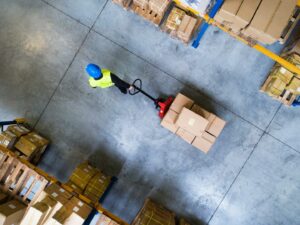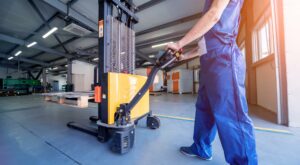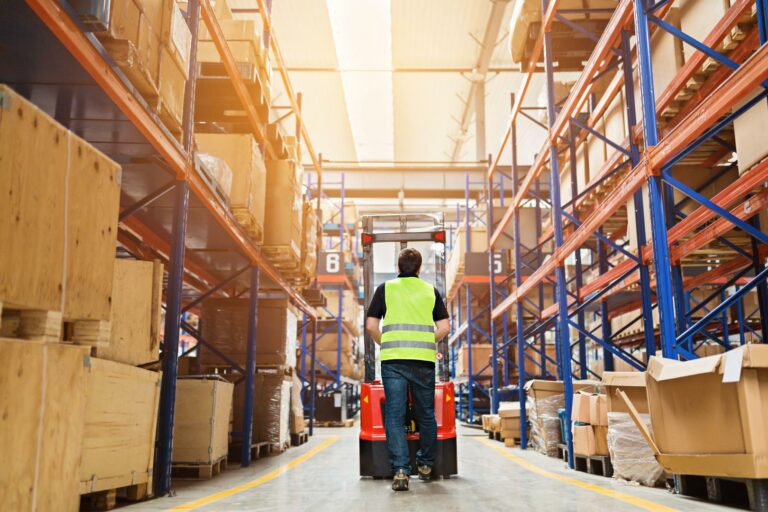It is a statistical fact: for many years now, diseases of the skeletal-muscular apparatus – i.e. bones, joints and muscles – have accounted for by far the largest proportion of days of incapacity to work. In 2019, 21.2 percent of the total 712.2 million days lost by all employees were due to a diagnosis falling under this category alone.

In the entire postal and logistics occupational group, the figures are even more serious. In an official survey conducted by the Federal Institute for Occupational Safety and Health in 2012, more than half of all respondents stated that they had experienced at least two musculoskeletal complaints in the previous twelve months. Not much has changed since then.
One reason for this is that although the regulations of the state and the employers’ liability insurance associations provide effective protection against accidents, they lack some of the clout that is needed to counteract lower-level stresses. Thus, through countless unergonomic actions, a disease develops bit by bit, which will break out in everyone at some point. Can anything be done about it? Yes, even with the following tips.
1. completely adjustable (office) furniture
Whether it is the desk of the warehouse manager or that of the commercial trainee: many of these workplaces have glaring ergonomic deficiencies. Although there are specifications and standards here too, in practice these are often not as strictly adhered to as the requirements that are supposed to prevent accidents.

The biggest single point of criticism: the furniture is not adjustable. There are usually adjustable office chairs, but these alone are not sufficient. Unless the desk also fits the height of the person, the effect of the chair is lost. The problem here is that fixed desks are designed for people of about 1.75 metres. Anything above or below this height cannot work ergonomically, and the strain increases the further the body height moves away from this dimension.
The tip is therefore that every office workplace should not only have comprehensively adjustable chairs, but also tables, computer screens and input devices. And, if new equipment is to be purchased, it should even be models that also allow standing work – because nothing is more ergonomic than a good mix of positions.
2. Big stairs, little trick, big effect
The regulations make precise specifications on how stair railings, handrails and the like must be designed. Unfortunately, however, the users are not taken to task as well. This is noticeable because accidents due to tripping and falling are significantly increasing around stairs. This is also true in warehouses, even if the steps there are made of metal mesh with maximum grip.
There is a trick that is enormously effective and only requires that this is clearly communicated to all employees:
People who walk up and down stairs always have one hand on the railing
and constantly looks in front of his feet. Neither are
materials with both hands, nor do they look at
mobile phones, clipboards or the like.
Numerous companies have already introduced such rules and immediately noticed a significant reduction in the causes of accidents.
3. help for the long runners
Many pickers only do this: picking, and if necessary packing. Depending on the size of the company, the pickers cover as many kilometres per working day as a good hiker – ten in practically every case, sometimes even three times that. In view of this, one important piece of ergonomic advice is to make sure that these “marathon runners” of logistics only get the best at the most important contact point of the movement, the sole of the shoe.

This not only applies in general to (work) shoes with an ergonomic inner and outer sole, but also extends to the replacement frequency: depending on body weight, even high-quality shoe soles are literally “worn out” after 500 to 1000 kilometres. Each additional kilometre not only puts a strain on the foot, but also on the entire musculoskeletal system, including the spine.
But if a picker “only” does ten kilometres per shift, this limit is already reached after 50 to 100 days. Yes, that may sound like a very short period of time. But anyone who uses this as an excuse to provide staff with new footwear only less frequently is ultimately harming themselves – especially since it is advisable to provide two pairs at the same time anyway, so that they can be worn alternately and allowed to dry out.
By the way: Incorrect footwear can also have the same consequences in the office, it just takes longer. Especially where there is no personal customer contact, company owners should therefore not only enable but encourage employees to wear ergonomic footwear – not just serious-looking models.
4. A mix of tasks
Do pickers always have to pick? Not with forward-looking workplace planning. It is extremely unusual for someone to have no contact with sedentary work at all, even among pure pickers.
With a little planning, it could be achieved, for example, that every running warehouse worker can complete a seated task after a certain distance. This could also be easily measured using pedometers. Instead of ten kilometres in seven hours followed by a sedentary hour, the day could thus be better divided for an ergonomic mix of movement – and the strain reduced.
5. More ergonomics at the packing table
Constant sitting is unhealthy, that is well known and the reason why so many pure office workers drop out of work every year. However, the other extreme is not much better either – standing for long periods of time puts enormous strain on the body, as does any forced posture.
Packing tables should therefore also be height-adjustable. If work is done in shifts, they should be comfortably adjustable (electrically, by crank etc.) so that each employee can adjust the table to his or her needs within seconds.
Furthermore, there should also be seating at these stations. There are very good solutions for this in other sectors in the form of the standing stool. It is not so much a place to sit as a place to lean. Alternatively, rider stools can be used, which have a swivelling seat, but a hemispherical floor support, enabling active “sitting”, which is supportive, but does not completely relieve the body.
By the way: It is very useful to get feedback from the packers in order to establish further improvements. For example, packing station systems or waste bins that can be reached without additional movement.
6. More electrics for transport
Electric assistance has been common for many years in the pallet truck, the “ant”. However, it has only become established there because of the often very heavy pallet weights, not because of primary ergonomics.

Yet this is precisely the focus. Whether it is bending, stretching, lifting or pulling and pushing, there is no movement that is really ergonomic in the long term if it has to be done with muscle power alone; especially if it is repetitive, i.e. constantly repeated.
This means that even if an order picker only has to move relatively light goods (also in terms of total weight) on his platform trolley, the constant pushing and braking is still a burden in total.
Especially because every form of logistical transport is now also offered with electric drives, this should be used more generously. Here, too, the purchase price is quickly offset by reduced downtime and more satisfied, because pain-free, employees.
7. More silence, less stress
No area of a logistics operation is quiet. It doesn’t matter whether it’s the ringing of telephones and the clattering of keyboards in the office or the constant background noise in the halls. Although the noise level is rarely so high that it is really harmful to health, other rules apply:
– Hearing protection only has to be worn at work above 80 decibels.
– At 60 decibels, however, long-term hearing damage is already possible.
– At 40 decibels, the ability to concentrate decreases.
It is above all the latter values that can easily be reached in logistics. Is there a remedy? Definitely.
– If it is not possible or desired to accommodate the office staff separately, they should also be encouraged to wear light hearing protection if possible.
– In halls where constant communication is necessary, on the other hand, active hearing protectors are recommended, possibly with integrated communication facilities (radio, for example) where necessary.
The goal should be for employees to hear only what they need to hear for professional communication. Any other noise that is blocked out helps to make the workplace more ergonomic because it reduces the constant exposure to sound, which is both stressful and damaging.









